Grove City, Urbancrest, Borror’s Corners, Cottage Mills, Ridpath
Jackson Township came into being in 1815 carved mostly from Franklin Township and a southwest portion of Pleasant Township. It was originally part of the Northwest Territory. The land was also part of the Virginia Military Land Grant. The grants were awarded Virginia’s Revolutionary War veterans as compensation for their military service.
The early years were difficult for those moving into Central Ohio. Roads were not much more than animal trails; those who chose to live in the township area braved a wilderness that was wild and sparsely settled except for Native American settlements.
Families lived in the area prior to 1815. The first permanent white settler in the area now known as Jackson Township was Hugh Grant Sr., his wife, Catherine Barr, and three children. Unable to identify the land purchased, Grant and family became squatters on the banks of the Scioto River. The Shawnee also had settlements near the river stretching from Columbus to Chillicothe.
The land was flat and fertile but it was also damp and not readily suitable for farming. As more people moved into the township, farmers drained acres of ground using clay tile diverting standing water into the natural runs that led to the Scioto River. Jackson Township had thick forests that included walnut, oak, sycamore, maple, beech, chestnut and tulip trees. There were numerous other smaller trees that included dogwood, wild plum, crab apple, redbud and pawpaw. Grapevines hung from many of the towering trees and there was a plentiful undergrowth of blueberry bushes, raspberry and blackberry vines that covered the landscape.
Malcom Borror with tractor at his Jackson Township home.
Neighboring Franklin County communities once referred to Jackson Township as the “backwoods township” because of the hardship settlers had to face. Many were of German descent who relocated from Pennsylvania.
Others made the move to Ohio from Virginia and Kentucky. The earliest pioneers didn’t arrive by covered wagons. Most passages were not more than narrow Native American trails; settlers arrived by foot, mule or horseback and sometimes a cart pulled by oxen or simply by human hands.
Settlers from northern states likely followed the Ohio River from Pittsburgh to Zane’s Trace near present day Wheeling, West Virginia. The trail led to Chillicothe and from there, settlers could follow the Scioto Trail north into Central Ohio. After Ohio became a state in 1803, efforts were made to improve the various trails to accept wagon traffic.
Settlers from Virginia and points east followed a path cut in 1775 by Daniel Boone that became known as the Wilderness Road. Kentucky residents moving north could get on Zane’s Trace at Maysville and follow the Trace north to Chillicothe. The land mass that became Ohio and Kentucky was once part of Colonial Virginia. In 1784, Virginia relinquished its western territory north to Canada including all lands west of the Ohio River to the United States to allow settlements.
Early Pioneer Settlers
Hugh Grant Sr., and family are considered the first permanent white settlers but at least one other individual arrived the same year as Grant. He was Percival Adams who also arrived in 1803. Grant was considered a successful hunter and harvested 82 deer in the township.
The township suffered greatly from good roads, but the construction of the Harrisburg, Franklin and the Cottage Mills Turnpikes, all passing through Jackson, improved access. Read about Grant history http://grovecityohhistory.org/grant-sawyer-home/.
Others included: Wollery Conrad (1804) (also known as Woolery Coonrod), Nicholas Haughn (1804), Samuel Breckenridge (1804), John White (1804), Samuel White (1805), Jonas Orders (1806), Joseph Hickman (1806), William Duff (1806), Henry Huffman (1807), John Hoover (1807), William Brown (1807), Jonah Smith, (1808) and Henry Baumgartner (1808).
Other early settlers were James Seeds, William Miller, Joseph Bennett, John Keyes, Magdalene Borror (widow of Jacob), John G. Neff, John Mitchell, Hawes Barbee, Valentine F. Shover, Abraham Miller, Andrew Gantz, John Haines, Zachariah H. Marsh, Wesley Preston, John Martino and John Houghn (Haughn).
In those early years, almost everything early residents consumed was grown on their farms. Commonly purchased items included crackers, rice, salt, sugar, coffee beans and molasses in gallon buckets.
The housewife was expected to put three large meals on the table every day. Because most people did physical work before breakfast, they were ready for a hearty meal. There would be fresh frying sausage or liver pudding, along with homemade bread, coffee cake and coffee. The noon meal was another large meal centered around meat and potatoes. Read more about Grove City at http://grovecityohhistory.org/grove-city/.
Other Facts
The first white child born in the township was Nancy Duff, in 1806, daughter of William C. and Catherine Duff. The first brick house was built by William Brown in 1814. The first sawmill was built by Robert Seeds on Turkey Run, a location that can no longer be identified on a map. Historic accounts say Seeds built a second mill on Grant’s Run. There is a possibility Seeds’ sawmill around 1850 was steam powered. Other early factories included drain tile operation, wagon factory, numerous blacksmith shops and general stores.
Churches
According to the Historical Publishing Company, reprinted in Reflections II, the first church in Jackson Township was the Scioto Chapel which was erected by the Christian Faith denomination that was organized in 1812. The Rev. Benjamin Britton of Norwich Township traveled to Jackson Township as early as 1828 to preach for the New-Lights believers living in the area. The New- Lights were frequently referred to as either Congregationalists or Baptists who embraced revivals to spread their faith. Another early pastor who came to Jackson Township was the Rev. Chandler Rogers, pastor of a Universalists congregation in Perry Township.
Prior to 1840, Methodist and Presbyterian circuit riders conducted services in the township. The first religious service in the Grove City community was conducted by the Rev. R. K. Davis, a Presbyterian minister who came to the area with William Foster Breck around 1846. Breck eventually became the founder of Grove City in 1852. A simple log building had been constructed for religious services and community meetings around 1846 that became known as the Highland Road Meeting House. It was also known as the Union Meeting House, Highland Mission House and the Highland Mission.
Besides worship services, village meetings were held in the building. It was located on land to the rear of the Carl Willert building on South Broadway. Festivals, dances, shows, and general gathering were held at the site. Seats in the building were elevated so all might have a clear view at various gatherings. After it served its purpose, the old building was deserted. A.G. Grant purchased it and moved it to his property as a barn.
Three denominations were born from the Highland Mission. They included a German-English Lutheran congregation in 1853, a Presbyterian church in 1856 followed by a Methodist Church in 1859.
The first church in Jackson Township was years earlier. It was a log building erected around 1839 identified as Concord Methodist Church. There were two other Methodist denominations. One was Hopewell, a wood building on the Jackson Turnpike, erected in 1839, and the other was Hickory Seminary, erected for the double purpose as a church and schoolhouse. The date is unknown.
Schools
The subscription school at Borror’s Corners was the only school in Jackson Township for many years. It opened in 1815. According to research by Harold and Faye Morland, the first public school was a log building in the Village of Grove City that opened for classes in 1853. It was operated by a Jackson Township Board of Education. For more information about township schools, go to http://grovecityohhistory.org/school-history/.
Township Fire Department Organized
ire and emergency services are among the most important functions of Jackson Township present day. The department, formed in May 1945, is one of the best trained departments in Ohio providing the highest quality of emergency services to residents. The department is rated among the top 1.5% of more than 49,000 fire departments in the United States.
In the early years, Grove City’s fire-fighting equipment amounted to having a bucket brigade with a wagon filled with water buckets. It also had a manual hand pump and hose. According to an account by Huldah Witteman Rader, her father, Henry Witteman, owned one of the first automobiles in Grove City. As such, he received an unusual request in 1911. At the time, Mrs. Rader said Grove City had a two-wheel fire wagon with hose but no engine. When there was a fire, residents had to get someone to pull the unit to the scene of the fire.
Harrisburg once had a major fire and the village requested assistance from Grove City. Mr. Witteman was asked if he would consider pulling the fire wagon to Harrisburg. He agreed. The wagon was hitched to his car and he headed south toward Harrisburg. According to her, the wagon swayed back and forth across the road all the way. Unfortunately, by the time Mr. Witteman arrived, the building was too far gone and couldn’t be saved.
The Village of Grove City purchased the first motorized fire truck in Jackson Township around 1922 and Olin Rumfield is believed to have been the first fire chief. By 1936, Grove City and Jackson Township had their own fire trucks.
They operated separate departments but shared volunteers and even occupied the same building. The township paid $25 a month rent to park in the Village garage.
When the fire tower siren would sound, volunteers would head to the station to find out the fire’s location. If it was a township fire, the white truck would be used; if the
fire was within the village, a red truck was used. Needless to say, there were times when a fire required both vehicles. Jackson Township built its first fire station on Broadway about a mile south of the downtown area the same time Grove City got out of the firefighting business.
Explosion, Fire on July 8, 1996
Quick action by the Jackson Township Fire Department on a Monday afternoon, July 8, 1996, prevented what could have been a major disaster at a propane facility on Broadway just south of the Town Center. Explosions and flames shot over 100 feet into the air and black smoke was visible for miles.
Jackson Township emergency crews and the Grove City Police Department responded within minutes after being notified by a township squad that happened to be in the area about 2:30 p.m. when the first explosion occurred.
A 33-gallon propane tank at Ferrellgas Company, 4401 Broadway, caught fire creating a cascading effect that ignited other nearby tanks. Many of those small tanks exploded and became airborne. Quick decisions had to be made by Fire Chief Danny Ashcraft. He ordered an evacuation of the immediate area and ordered fire crews to fill the area with water.
A major concern was the 30,000-gallon propane tanks in the immediate area. The one closest to the fire was at Ferrellgas, another 30,000-gallon propane tank was at Southern Propane next door; three others were sitting on a rail car behind the two properties.
“If any of those tanks breached, we were in trouble,” Assistant Fire Chief Les Guy was quoted saying in The Grove City Record. “It would have gone off like a rocket and there’s no telling where or what it could have hit.” Guy added there was a potential for a major catastrophe. Since the main fire couldn’t be extinguished, fire crews turned their attention to keeping water on the scene.
A large area was evacuated as Jackson Township and other departments poured thousands of gallons of water on the property. Columbus Fire and neighboring township departments responded to provide mutual aid assistance at the four-alarm blaze. The Franklin County Sheriff’s office also responded with officers and a mobile command post.
Gasoline Fire at Bonded Station
A second afternoon fire occurred at the Bonded Oil Station on North Broadway about 4:30 p.m. Fire crews rushed to the scene with one thought in mind, could it be related in any way to the propane fire at Ferrellgas. For a brief time, there was concern propane might have somehow seeped into the storm sewers, but that didn’t occur.
A 71-year-old man was pumping gasoline when the station fire ignited. Although it was quickly extinguished when fire crews arrived, the vehicle was a total loss. The driver was rushed by Med Flight to the Ohio State University Medical Center with first and second degree burns to his head, arms and chest. The station manager shut off gas to the pumps when the fire occurred but the building sustained heavy damage.
Memories of 1996 Explosions
Most people who have lived in Grove City at least the past 25 years have memories of the Ferrellgas fire. One might say the experience was burned into their memory. These are a few remembrances from 1996.
Vicky Whitten: “Yes, I do remember that day of the explosion and think of it every time I drive by Ferrellgas on Broadway. At that exact moment of explosion. I was at an appointment near Holly Hill and Clime Road. We could feel that blast at that location and I knew it was from the Grove City area but didn’t know where or what happened. My first concern was my small children whom I left with their grandmother in Grove City who lived near Bryson, Clark and Woodgrove. I left my appointment immediately to check on my children and family. Thank goodness they were in a safe zone far enough away from the fire. I had some difficulty and anxiousness getting around the road blocks throughout areas of Grove City going to my mother’s home to make sure they were safe.”
Michael Esposito: “We were home on the day of the explosion. We heard the explosion and felt the ground shake. Once we found out what had happened, our concern was for the people working there and that the explosion would cause a major fire in the south side of town. Thanks to Jackson Township Fire Department all was taken care of quickly. I can’t believe how long ago that happened.”
Tom Rutan, Grove City High School Principal: “I recall that tragedy clearly. I received a call while at a doctor’s appointment that there had been an explosion and local authorities wanted to evacuate the area near that site out of an abundance of caution. They asked to use the high school as a relocation site until an all-clear was issued. I immediately agreed and returned to the school to welcome anyone needing a safe site to relocate. Since school was not in session at the time, opening for this purpose was easy to do and the right thing to do under the circumstances. Several local residents came to the school and remained there until the all clear was issued by emergency officials. Our staff welcomed everyone and hoped that injuries from the blast were minimal. By early evening, everyone was cleared to return to their homes and the building was secured.”
William R. Graul: “I had dealings with Hollingsworth Sign Company back then which was next to a chain link fence that separated them from the Ferrellgas plant. Al Hollingsworth and Helen Hollingsworth (now deceased) gave me a couple of stories. When it happened, Al was not there but Helen was. She told me she first heard some loud pops and wondered what was going on. She looked out the door and saw individual containers blowing up. Although shocked, she had sense enough to get out of the building and head up the railroad track because she knew of the possibility of a much worse danger if the large tanks in the plant blew up. Al told me later that Helen was passed by Larry Beavers (also deceased) sprinting along the track. I personally remember turning on the TV when I heard what was going on and while I was watching a fire started at the old Bonded Oil station north of Our Lady. I think it’s a Speedway now. There was gasoline on fire all around the pumps, but I don’t know for sure how the fire was started. The news people were worried that the whole station might blow up, but it didn’t.”
Grove City – 1852
In 1852, William Foster Breck created a plat for the first village in Jackson Township which he named Grove City.
Others involved with the creation of Grove City included Jeremiah Smith, Breck’s brother-in-law, William Sibray, a brick mason and plasterer, and George Weygandt, a carpenter.
Some believe the village name came from the many groves of trees on Breck’s property. He had purchased the 151⁄4 acres from his father-in-law, John Smith of Worthington.
Grove City grew into a farming community where hogs were raised for market. Corn was another important crop along with various grains.
Grains and livestock were shipped on a feeder canal from Shadeville to where it the canal merged with the Ohio-Erie Canal then making its way to Cincinnati, once nicknamed Porkopolis because of its many slaughterhouses.
A few lines from a poem by Yvette L. Maurey tells a story about early farm life in Jackson Township.
Sis and I pulled out the tractor
and the hay rake from the barn.
The hay was dry and ready
to take in from the field on our farm.
We hitched the tractor to the rake;
Annie, the driver, was only nine.
I was eleven. The job of working
the rake lever was mine.
Jackson Township existed 37 years without a post office. Breck opened a post office in the new village in 1852. In the 1840 census, only 784 people lived in the township but just 10 years later the population had almost doubled to 1,550. Read more about the development of the new village at History/Grove City.
Village of Urbancrest
Nearly 40 years after Grove City became a village, another community was platted just to the north. In 1890, Urbancrest appeared as a settlement for 30 African Americans. The first family to settle the area was Samuel and Ella Quinichett. Two years later, as more people moved into the community, the Quinichett family held worship services in their home. This eventually led to the formation of the Union Baptist Church in 1892, a pillar of the community still today.
The community is now racially mixed and covers approximately 100 acres. Incorporated in 1948, Eugene Seabury was appointed the first mayor and Hannibal Johnson was the first person elected mayor.
Some of the most memorable residents include:
• Ellen Walker Craig-Jones, the first African American female mayor elected in the United States.
• The Rev. Dr. Nelson W. Trout, the first African American elected bishop to serve the American Lutheran Church.
• Gary Steven Burley, professional football player for the Cincinnati Bengals and the Atlanta Falcons.• Bob Hitchens, professional football player with the New England Patriots, Kansas City Chiefs and the Pittsburgh Steelers.
• Lonnie Carmen, mechanic and inventor who built and flew his own airplane.
Ellen Walker Craig-Jones was elected mayor and served from 1972-1975. She won the election by 11 votes resulting in a recount but the election results were confirmed in her favor. Mrs. Craig and her husband, James Craig were a working political team very interested in improving the community for its residents. Born June 5, 1906, in Franklin County, Ohio, she entered the political arena when only 20 years old and appeared before the Franklin County Commissioners seeking support for municipal water service for the village. She wasn’t successful but in 1960, as an Urbancrest council member, she and Mayor William Johnson went to Chicago seeking help for water and sewer service. In 1970, she worked closely with U. S. Congressman Chalmers P. Wylie making her dream a reality. The village water and sewer system became reality. She and others also worked to improve the community with new housing, street lights, signage and street improvements. During her years of community service, she received nearly 100 awards and honors.
The Rev. Dr. Nelson Wesley Trout grew up in Urbancrest and graduated from Grove City High School in 1939. He was born in 1921 and died in 1996. He was the first African American elected bishop to serve the American Lutheran Church which included the 144,000 member South Pacific District. That district included California, where he made his residence, Nevada, Utah, Arizona, New Mexico, Hawaii and portions of Texas. Before becoming a bishop, he was a professor and director of minority ministry studies at Trinity Lutheran Seminary in Columbus. Following his death at age 76, Trout was commemorated in the Lutheran Church Calendar of Saints. Trout was considered a powerful preacher in the Lutheran Church serving congregations in Alabama, California and Wisconsin. He was also a friend and colleague of Dr. Martin Luther King, Jr. He also once served as the executive director of Lutheran Social Services in Dayton. No doubt he was also proud of his niece, famed jazz singer, Nancy Sue Wilson. She was born in Chillicothe and was a West High School graduate in Columbus. She was a major figure in the national civil rights movement.
Gary Steven Burley of Urbancrest, is a graduate of Brookpark Middle School and Grove City High School. He is an alumnus of the University of Pittsburgh and played professional football as a defensive end for the Cincinnati Bengals and Atlanta Falcons in the National Football League. He also played in Super Bowl XVI. After his professional football career, Burley worked with gifted and talented middle and high school athletes across the United States. In 2006, he founded the Pro Start Academy for students 12-17 in Birmingham, AL. The organization encouraged young people in athletic abilities, academic achievement and life skills.
Robert (Bob) Hitchens was another outstanding athlete. Born in 1952, he also grew up in Urbancrest and was a graduate of Grove City High School in 1970 where he excelled in football, basketball and track. Hitchens also earned a full scholarship for football at Miami University in Ohio. He received honors as a tailback in the Mid-America Conference while attending Miami University. He was honored as most valuable player, offensive player of the year and named All- American by the Associated Press. He played professional football with the New England Patriots, Kansas City Chiefs and the Pittsburgh Steelers. He was inducted into the Miami University Hall of Fame. He was an assistant football coach at Carnegie-Mellon University and
at Miami University.
Lonnie Carmen of Urbancrest was a mechanic by trade and inventor by choice. He loved flight and according to Arnett Howard, Lonnie was the first black aviator in Central Ohio. Unable to purchase his own airplane in 1926, he built one in his backyard with a salvaged motorcycle engine. He had no written plans but was able to construct an airplane that he flew. It was reported he would take flight and land on a village street but that is not a known fact. For some reason, he feared vandals would damage his aircraft so he kept it out of sight inside a barn on his property when not in use. By the 1930s, Lonnie had purchased his own Piper Cub and every Saturday, weather permitting, he took his family in his Franklin motor car to a nearby airport for rides in his airplane. It’s possible he might have used one of the early air fields in Grove City. The one nearest Urbancrest was located on the east side of Broadway between Parlin and Addison. On Sundays, Carmen and his family headed for Port Columbus, now John Glenn Columbus International Airport, to watch commercial aircraft take off and land. Known as a family man, he and his wife, Anna, raised their family in the village. He is remembered as a man who was able to solve most any mechanical problem.
Borror’s Corners
Borror’s Corners is best known today as the intersection of State Routes 104 and 665, but in 1820, it was Jackson Township’s first community. The land was part of an original grant in Franklin and Pickaway Counties held by Dr. Robert Rose, a surgeon during the Revolutionary War. Christopher Strader Sr. purchased the 1,600 acres in 1787 as part of a settlement of the Rose family estate.
Strader’s daughter, Magdalene, married Jacob Borror, Jr. in 1785. Her husband, a Revolutionary War veteran, died in Hardy County, Virginia (now West Virginia) in 1804 after an apparent heat stroke suffered recovering a deer he had killed.
In 1809, her three eldest sons, Martin, Jacob II and Solomon, relocated to Franklin County and began clearing land that belonged to their grandfather, Christopher Strader. About 1811, two years later, Magdalene and her other children, Isaac, Christine, Myomi and Absalom, moved to the Strader property her sons had cleared. In 1825, Magdalene Strader Borror’s father died. He had willed each of her heirs 250 acres in Jackson Township.
As early as 1815, the year Jackson Township was created, residents of Borror’s Corners opened the first school. It was a private, subscription school built on land owned by Solomon Borror.
Twenty students from the Borror, Miller, Seeds, Fishel and Fitzgerald families attended classes taught by Asa Davis. Families paid a modest teacher’s salary, provided school supplies along with room and board for the teacher, typical for that period of time. Ten years would pass until schools were supported by township property taxes.
The first church services in that area of the township were held in the home of William Miller in 1812. Three years later a log church was built on land owned by Christopher Strader. By 1850, the Scioto Chapel was built on the land of Absalom Borror near what is now Hiner Road and Jackson Pike.
Magdalene and her family prospered and many of today’s township residents are descended from that family. Borror’s Corners was the center of activity for the township, having a store, blacksmith and carpentry shops. Absalom Borror, a son of Magdalene, died in 1891. He was the last member of the original Borror family.
Several of the Borror homes still stand. An Ohio Historical Marker at Borror’s Corners was dedicated June 28, 1996 at a Borror Family Reunion.
Shadeville (Cottage Mills)
Now located in Hamilton Township, Shadeville was once part of Franklin Township as was Jackson Township. Shadeville was best known to many Jackson Township farm families as the home for Cottage & Mills, a large grist mill located near present day State Route 665 and US Route 23 at the Scioto River that was the first step to reaching the Ohio Erie Canal system.
Captain Adin G. Hibbs moved from Pennsylvania in 1832 and created a plat for the Village of Shadeville. People who lived in the area at the time identified so much with the business that they often included Cottage Mills, not Shadeville, as a return address on their mail. Information about the mill was uncovered in an insurance policy issued by The North Western Insurance Company dated Feb. 4, 1864. The policy was in the possession of Louie and Joan Eyerman. The policy provided $2,000 coverage for the stock of wheat contained in a three-story grain tower on the premises of “Cottage & Mills”.
Coverage was also in place for the contents of a one-story warehouse that was located 18 feet east of the mill. A provision in the policy allowed the insured, Hughes and Rockefeller, to qualify for an additional $7,000 insurance if needed. The policy, which cost $15, lists the insured premises as the Shadeville Mill.
A feeder canal from the mill to Lockbourne where it connected with the Ohio-Erie Canal helped promote the business. That was a principal means for farmers to ship grain and livestock to markets both north and south. Jackson Township resident Grace Orders was once quoted as saying wagons filled with grain would back-up for more than a half mile waiting to cross the bridge over the Scioto River to get to the mill.
Ridpath – Tuckyhuddle
About 1875, a small community sprang up in southeast Jackson Township near Concord Church at London-Groveport Road and Hoover Road. The new settlement was established in anticipation of another railroad company coming through the area. The settlement was named Ridpath but more commonly called as Tuckyhuddle. There is no indication where the names originated or what the actual meanings were.
The Ohio Southern Railroad started a branch line to Columbus from the Portsmouth area after 1881, according to research by Roland L. (Lum) Edwards, Grove City administrator-engineer in the 1970s. Work on the railroad bed progressed north to Grove City but ended in the area between Birch Bark Trail and Stargrass Avenue. Financial difficulties prevented track from ever being laid at Ridpath.
Expecting the area would have a station and freight office, businesses opened including a country store, blacksmith shop and shoe shop. At one point, the settlement even had a post office. However, when the possibility of the new rail line collapsed, those Ridpath merchants relocated to Grove City and other parts of Jackson Township. Evidence of the old rail bed is still visible in parts of the area.
In 1884, Jackson Township got its first completed rail line. A construction gang for the Columbus, Cincinnati and Midland Railroad reached Grove City in March 1884. Later that year, trains rolled through Jackson Township shipping cattle, hogs, grains and lumber from the Grove City freight station.
Historic Moments in Pictures
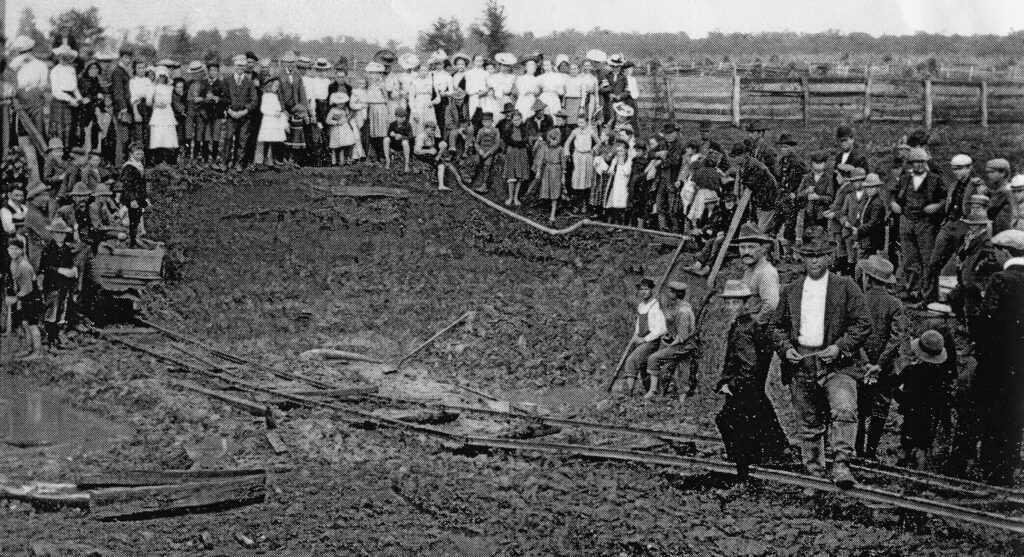
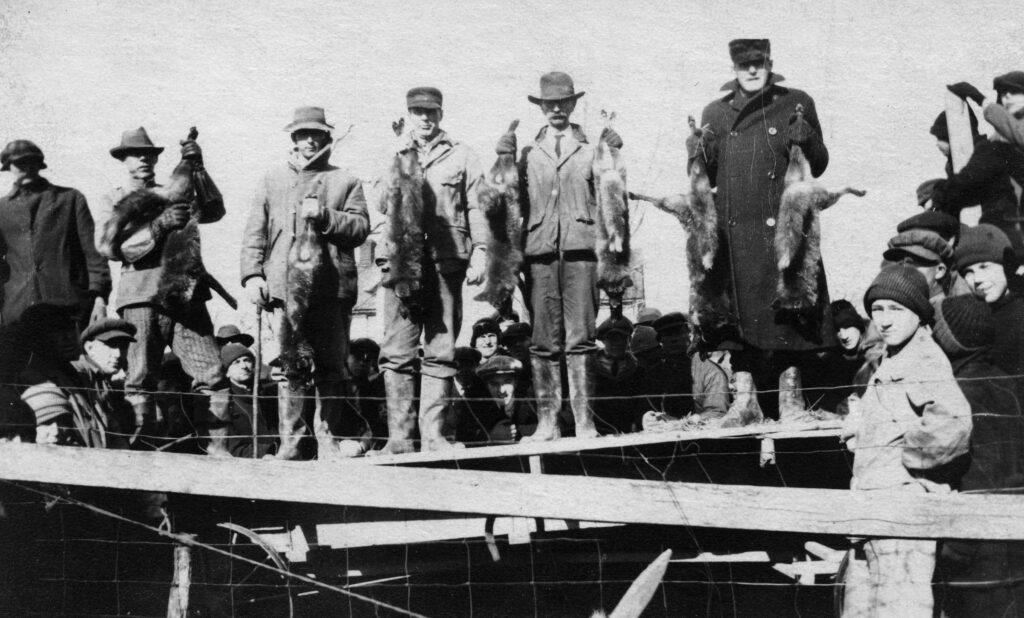
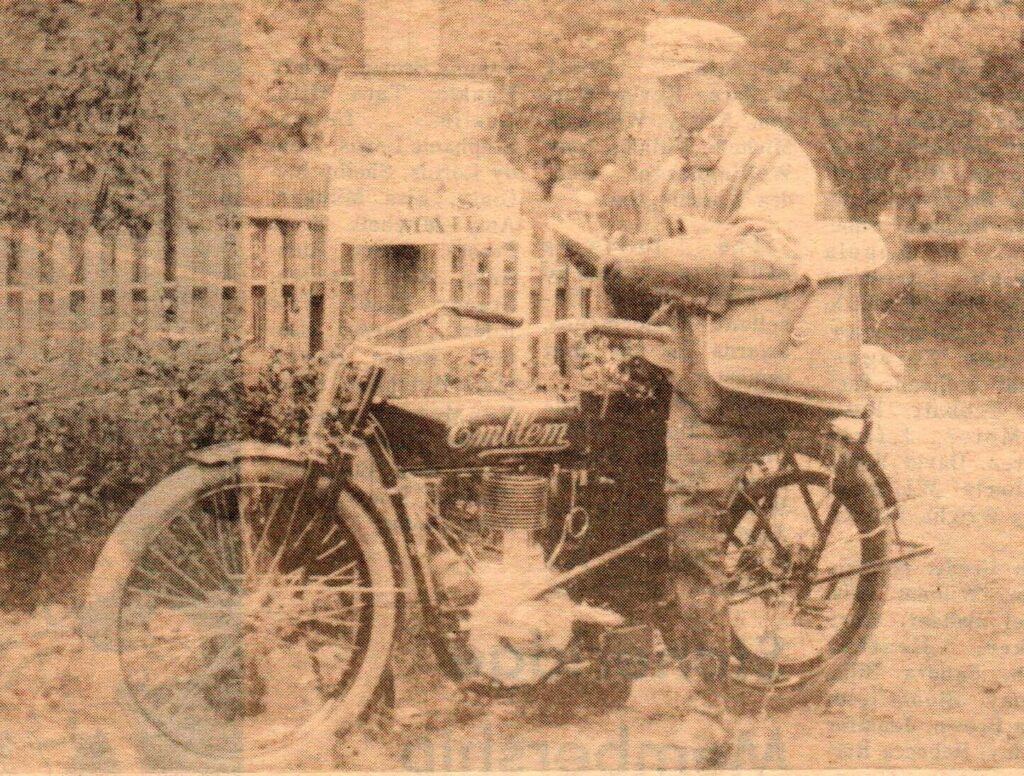
Howard Fisher delivered mail on a motorcycle. His RFD 4 (rural free delivery) route out of Grove City.
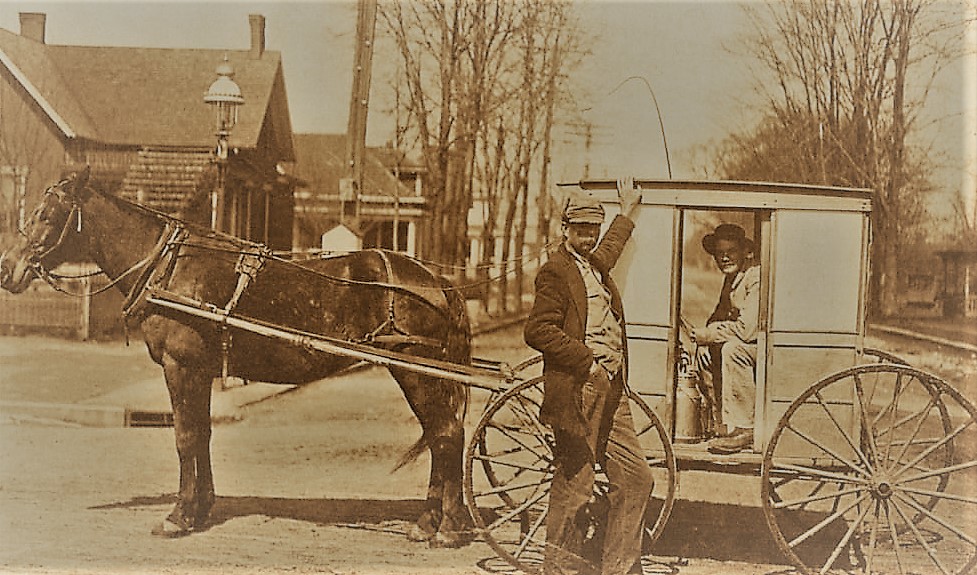
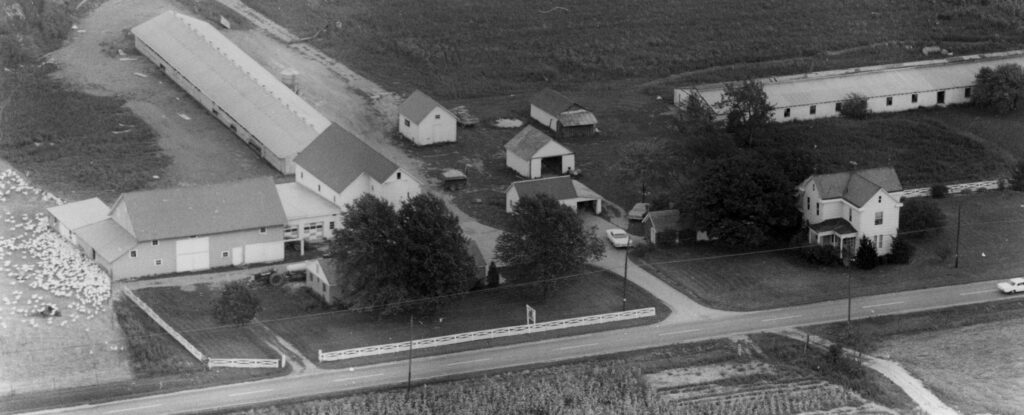
BOOKS, PAMPHLETS and PUBLICATIONS at GROVE CITY WELCOME CENTER and MUSEUM
History of Jackson Township and Early Pioneers Harold Windsor
Reflections Marilyn Gibboney
Reflections II Marilyn Gibboney
Images of America, Grove City Janet Shailer, Laura Lanese
Images of America II Shailer, Lanese, Kelli Milligan Stammen
William Foster Breck James F. Hale
Village Marshal Reprint
The One Room Schools James F. Hale
Epoch of the Park Street School Harold, Faye Morland
Grove City High School Baseball Limited Supply
Adam Gantz Story Limited Supply
A Collection of Essays Young Historians
Gantz Farm, National Landmark James F. Hale
Greyhound Racing, Grove City James F. Hale
History of Old Grain Mills and Mill Street James F. Hale
Trouble on Scioto’s Waters Janet Shailer
WEB NARRATIVE AND PHOTO SELECTIONS BY JAMES F. HALE, 2021
SOURCES INCLUDE:
Southwest Franklin County Historical Society files
Southwest Public Library
Dick Shover, Borror family historian
History of Franklin and Pickaway Counties, 1796; reprint 1880
The Rev. John Gray, United Methodist Pastor, Historian, Genealogist
Grove City Record, July 8, 1932
Epoch of the Park Street School 1853-1964
Greyhound Gazette, April 1932, publication of Grove City High School
Jackson Township 1872 map
Wikipedia – Zane’s Trace
Linda L. Lewis, Paul Grossman, Joan Eyerman, Mike Boso, Jack Maurey, Richard L. Stage
This article and information was compiled and written by James F. Hale from historical records of the Southwest Franklin County Historical Society in 2014.





